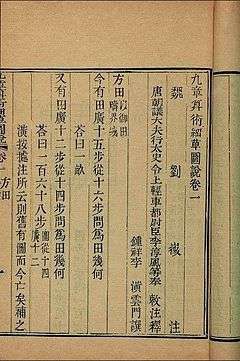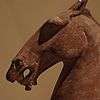The Nine Chapters on the Mathematical Art

The Nine Chapters on the Mathematical Art (simplified Chinese: 九章算术; traditional Chinese: 九章算術; pinyin: Jiǔzhāng Suànshù; Wade–Giles: chiu3 chang1 suan4 shu1) is a Chinese mathematics book, composed by several generations of scholars from the 10th–2nd century BCE, its latest stage being from the 2nd century CE. This book is one of the earliest surviving mathematical texts from China, the first being Suan shu shu (202 BCE – 186 BCE) and Zhoubi Suanjing (compiled throughout the Han until the late 2nd century CE). It lays out an approach to mathematics that centres on finding the most general methods of solving problems, which may be contrasted with the approach common to ancient Greek mathematicians, who tended to deduce propositions from an initial set of axioms.
Entries in the book usually take the form of a statement of a problem, followed by the statement of the solution, and an explanation of the procedure that led to the solution. These were commented on by Liu Hui in the 3rd century.
History of the book
The full title of The Nine Chapters on the Mathematical Art appears on two bronze standard measures which are dated to 179 CE, but there is speculation that the same book existed beforehand under different titles.[1]
Most scholars believe that Chinese mathematics and the mathematics of the ancient Mediterranean world had developed more or less independently up to the time when the Nine Chapters reached its final form. The method of chapter 7 was not found in Europe until the 13th century, and the method of chapter 8 uses Gaussian elimination before Carl Friedrich Gauss (1777–1855).[2] There is also the mathematical proof given in the treatise for the Pythagorean theorem.[3] The influence of The Nine Chapters greatly assisted the development of ancient mathematics in the regions of Korea and Japan. Its influence on mathematical thought in China persisted until the Qing Dynasty era.
Liu Hui wrote a very detailed commentary on this book in 263. He analyses the procedures of the Nine Chapters step by step, in a manner which is clearly designed to give the reader confidence that they are reliable, although he is not concerned to provide formal proofs in the Euclidean manner. Liu's commentary is of great mathematical interest in its own right. Liu credits the earlier mathematicians Zhang Cang (fl. 165 BCE - d. 142 BCE) and Geng Shouchang (fl. 75 BCE-49 BCE) (see armillary sphere) with the initial arrangement and commentary on the book, yet Han Dynasty records do not indicate the names of any authors of commentary, as they are not mentioned until the 3rd century.[4]
The Nine Chapters is an anonymous work, and its origins are not clear. Until recent years, there was no substantial evidence of related mathematical writing that might have preceded it, with the exception of mathematical work by those such as Jing Fang (78–37 BCE), Liu Xin (d. 23), and Zhang Heng (78–139) and the geometry clauses of the Mozi of the 4th century BCE. This is no longer the case. The Suàn shù shū (算數書) or writings on reckoning is an ancient Chinese text on mathematics approximately seven thousand characters in length, written on 190 bamboo strips. It was discovered together with other writings in 1983 when archaeologists opened a tomb in Hubei province. It is among the corpus of texts known as the Zhangjiashan Han bamboo texts. From documentary evidence this tomb is known to have been closed in 186 BCE, early in the Western Han dynasty. While its relationship to the Nine Chapters is still under discussion by scholars, some of its contents are clearly paralleled there. The text of the Suàn shù shū is however much less systematic than the Nine Chapters; and appears to consist of a number of more or less independent short sections of text drawn from a number of sources. The Zhoubi Suanjing, a mathematics and astronomy text, was also compiled during the Han, and was even mentioned as a school of mathematics in and around 180 CE by Cai Yong.
Table of contents
Contents of The Nine Chapters are as follows:
- 方田 Fangtian - Bounding fields. Areas of fields of various shapes, such as rectangles, triangles, trapezoids, and circles; manipulation of vulgar fractions. Liu Hui's commentary includes a method for calculation of π and the approximate value of 3.14159.[5]
- 粟米 Sumi - Millet and rice. Exchange of commodities at different rates; unit pricing; the Rule of Three for solving proportions, using fractions.
- 衰分 Cuifen - Proportional distribution. Distribution of commodities and money at proportional rates; deriving arithmetic and geometric sums.
- 少廣 Shaoguang - Reducing dimensions. Finding the diameter or side of a shape given its volume or area. Division by mixed numbers; extraction of square and cube roots; diameter of sphere, perimeter and diameter of circle.
- 商功 Shanggong - Figuring for construction. Volumes of solids of various shapes.
- 均輸 Junshu - Equitable taxation. More advanced word problems on proportion, involving work, distances, and rates.
- 盈不足 Yingbuzu - Excess and deficit. Linear problems (in two unknowns) solved using the principle known later in the West as the rule of false position.
- 方程 Fangcheng - The two-sided reference (i.e. Equations). Problems of agricultural yields and the sale of animals that lead to systems of linear equations, solved by a principle similar to Gaussian elimination.
- 勾股 Gougu - Base and altitude. Problems involving the principle known in the West as the Pythagorean theorem.
Accessibility
- Abridged English translation: Florian Cajori: Arithmetic in Nine Sections, 1893.
- Abridged English translation: Lam Lay Yong: Jiu Zhang Suanshu, An Overview, Archive for History of Exact Science, 1994 Springer Verlag.
- A full translation and study of the Nine Chapters and Liu Hui's commentary is available in SHEN Kangshen "The Nine Chapters on the Mathematical Art" Oxford 1999. ISBN 0-19-853936-3
- A French translation with detailed scholarly addenda and a critical edition of the Chinese text of both the book and its commentary is Chemla, Karine, and Shuchun Guo. 2004. Les neuf chapitres: le classique mathématique de la Chine ancienne et ses commentaires. Paris: Dunod. ISBN 978-2-10-049589-4.
- German translation: Kurt Vogel: Neun Bücher Arithmetischer Technik, Friedrich Vieweg und Sohn Braunsweig 1968
- Russian translation: E. I Beriozkina: Mathematika V Devyati Knigah (Математика в девяти книгах), Moscow Science Press 1980.
- Japanese translation.
See also
Notes
References
- Needham, Joseph (1986). Science and Civilization in China: Volume 3, Mathematics and the Sciences of the Heavens and the Earth. Taipei: Caves Books, Ltd.
- Straffin, Philip D. "Liu Hui and the First Golden Age of Chinese Mathematics," Mathematics Magazine (Volume 71, Number 3, 1998): 163–181.
- O'Connor, John J.; Robertson, Edmund F., "Liu Hui", MacTutor History of Mathematics archive, University of St Andrews .
External links
| Chinese Wikisource has original text related to this article: |
- Full text of the book (Chinese)
